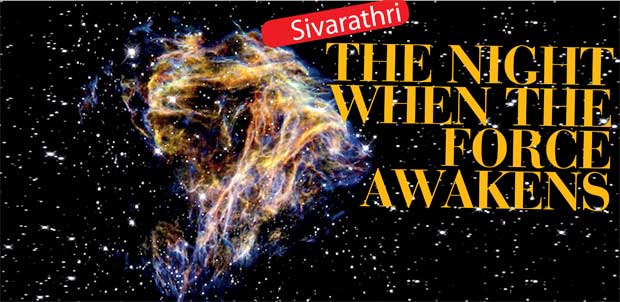Reply To:
Name - Reply Comment
Last Updated : 2024-04-19 00:03:00



s is common in Hinduism, Maha Sivarathri has many different explanations about the observation. However, first and foremost Maha Sivarathri is NOT a festival but a religious observation.
One may wonder why it is called Maha Sivarathri, instead of just Sivarathri. By the way it is Siva not Shiva.
True enough, every month there are Sivarathris called Matha Sivarathri (Monthly Siva Rathri). So, the special one came to be known as Maha Sivarathri as it is more important than the rest.
So do the Goddesses have their own important rathris e.g. Navarathri part of which is the Saraswathie Pooja.
According to Hinduism man is kept away from salvation or Parinirvanam (similar to the Nibbana) by his ego. Hinduism aims to help man in various ways to get over this and help him become one with the Brahman/ Purusha which is the Supreme Being. Only those who achieve Paripakkuvam –that is the balance of good Karma and bad Karma- qualifies a being to escape the cycle of Samsara.
Here I must mention that the Brahhman is different from Brahmma the Creator.
Brahmma is the God of Creation. Brahmman is Purusha the Supreme Being. The Force of Star Wars if you want to have it that way.
One might ask what is the Supreme Being. Purusha is not an “Ever loving father the God”; nor a Loving God who punishes “non-believers” and give virgins to the martyrs.
It’s neither a he; nor she; nor it. It’s according to Hinduism a force beyond human comprehension.
Purusha is a complex concept whose meaning evolved in Vedic and Upanisha times. It means the cosmic being or Self, Consciousness, and Universal Principle.
In early Vedas, Purusha meant a cosmic man whose sacrifice by the Gods created all life.
This was one of many creation theories discussed in the Vedas. The idea parallels Norse Ymir, with the myth’s origin in Proto-Indo-European religion.(Wiki)
“In the Upanishads, the Purusha concept no longer meant a being or cosmic man. The meaning evolved to an abstract essence of Self, Spirit and the Universal Principle that is eternal, indestructible, without form and all pervasive,” it says.
The Purusha concept is explained with the concept of Prakrti in the Upanishads. The universe is envisioned, in these ancient Sanskrit texts, as a combination of perceivable material reality and non-perceivable, non-material laws and principles of nature.
Material reality, or Prakrti, is everything that has changed, can change and is subject to cause and effect. Purusha is the Universal principle that is unchanging, uncaused but is present everywhere and the reason why Prakrti changes, evolves all the time and why there is cause and effect. Purusha is what connects everything and everyone, according to various schools of Hinduism.
There is a diversity of views within various schools of Hinduism about the definition, scope and nature of Purusha.
This what, the lies behind the observation of the Maha Sivarathri. This is what the observation of Sivarathri tries to explain to followers of Hinduism. The Cosmic beam of light helps the laymen in understanding better the transience of material body, life, and world as we know it.
Despite this, there are several mythical stories that try to explain Maha Sivarathri, the correct one or the one that comes closest to the Hindu Philosophy of life is this according to Saivaites.
Many might know that in Hinduism, more or less like Christianity, also has a Trinity, Siva the Destroyer, the Vishnu the Protector and Brahmma the Creator. Of these three supreme Gods Saivaites. Consider Siva as the Supreme One, while Vaishnavaites consider the Vishnu. Brahmma although the creator is not worshiped or do not have temples.
As the story goes, once there was a debate among the three over who was supreme. And as the argument proceeded Siva turned into a Cosmic beam of light spanning the entire universe/cosmos.
The midnight abishekam on the Sivarathri is special as it signifies this particular event- it is believed that it was the time that Siva turned in to the cosmic beam of light. This is known as Lingodbhava.
And he wanted Vishnu and Brahmma to find either the top or the bottom stem of the beam and challenged that if one of them finds as challenged, he should accept defeat and submit.
Vishnu decided to go in search of the root and turned himself into a wild boar. While, Brahmma turned into a swan and started flying up and up in the hope of finding the top.
After a long and tiring effort Vishnu gave up and conceded defeat.
But Brahmma would not. As he was flying higher and higher he met a highly fragrant Thaazham flower (Pandanus odorifer) falling from the top, presumably from the head of Siva.
Brahhma struck a deal with the Thazham Flower that he would return to Vishnu and tell that he had reached the top and that the flower was a witness. The flower also falsely testified that what Brahmma said as true.
This made Siva angry and he decreed that Brahhma should not have temples nor should he be worshipped. The flower that testified falsely was also prohibited from poojas and rituals.
So that is it. Maha Sivarathri is the night this happened. We do not know. As quoted earlier in one of my articles, Ananda Coomaraswamy says in his the Dance of Siva that Hinduism is complex system of symbols and we need to interpret this in terms of Hindu Purusha Theory.
We see that Vishnu being the God of protection surrendering with himself white flag leaving his ego behind. But Brahhma did not. The one who renounced ego wins. The naughty Brahhma gets an earful in addition to being excommunicated from the pantheon.
We can see that ego plays a big part in this episode. Ego (not the Freudian) is the last to leave a soul when one leaves the material body. That is what binds us with everything material. This is the underlying fact.
Maha Sivaratri is celebrated annually in reverence of the God Siva. Some say it is the day Siva was married to the Goddess Parvati. The Maha Sivaratri, also popularly known as Sivaratri (spelt as Sivaratri, Shivaratri, Sivarathri, and Shivarathri) or Great Night of Siva, marks the convergence of Siva and Shakti according to some interpretation.
Maha Sivaratri is celebrated on the Krishna Paksha Chaturdashi of the Hindu calendar month Maasi as per Amavasya (New moon /no moon).
As per Poornima-ant month calculation, the day is Krishna Paksha Trayodashi or Chaturdashi of Hindu calendar month Phalguna which falls in February or March as per the Gregorian calendar. Of the twelve Sivaratris in the year, the Maha Shivarathri is the most holy.
The festival is principally celebrated by offerings of Bael leaves to Siva, all-day fasting and an all-night-vigil.
There is a explanation for that as well...
Penances are performed in order to gain boons in the practice of Yoga and meditation, in order to reach life’s highest good steadily and swiftly.
On this day, the planetary positions in the Northern hemisphere act as potent catalysts to help a person raise his or her spiritual energy more easily. The benefits of powerful ancient Sanskrit mantras such as Maha Mrityunjaya Mantra increase greatly on this night.
Some say that on this particular night the human strength achieves its highest power. So that artistes perform throughout the night at temples.
On Maha Sivaratri, Nishita Kala is the ideal time to observe Siva Pooja. Nishita Kala celebrates when Lord Siva appeared on the Earth in the form of Linga. On this day, in all Siva temples, the most auspicious Lingodbhava Puja is performed.

Add comment
Comments will be edited (grammar, spelling and slang) and authorized at the discretion of Daily Mirror online. The website also has the right not to publish selected comments.
Reply To:
Name - Reply Comment
On March 26, a couple arriving from Thailand was arrested with 88 live animal
According to villagers from Naula-Moragolla out of 105 families 80 can afford
Is the situation in Sri Lanka so grim that locals harbour hope that they coul
A recent post on social media revealed that three purple-faced langurs near t